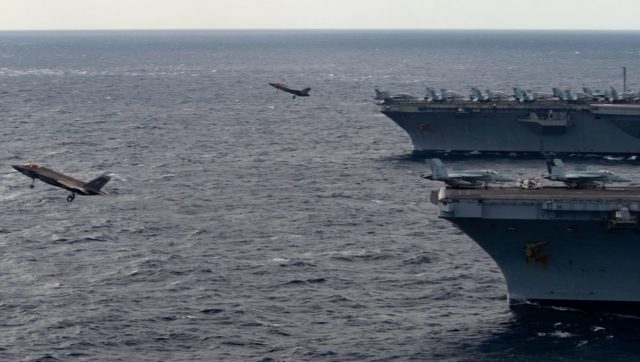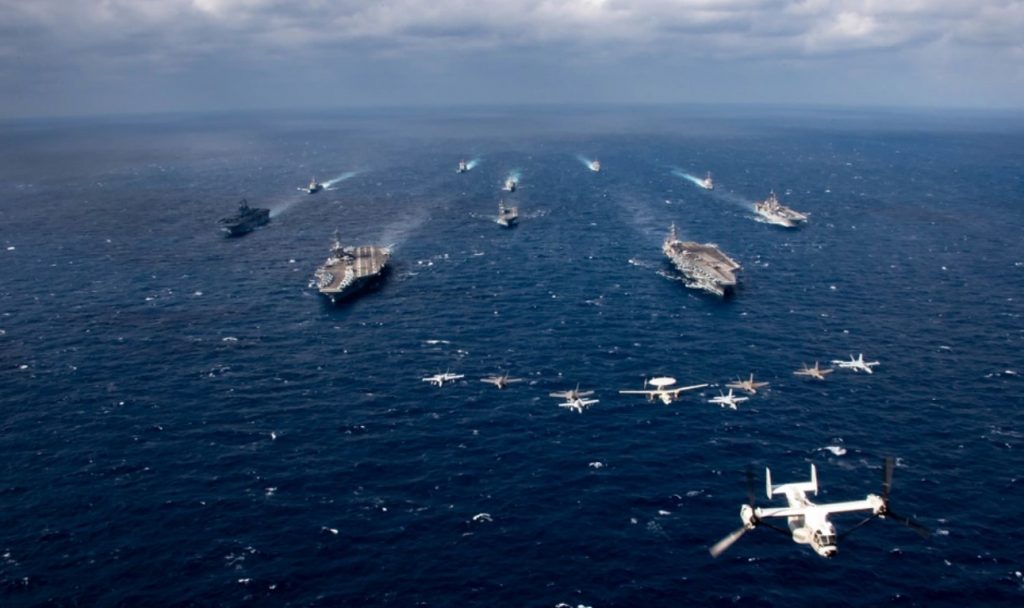
US Navy carrier strike groups assembled around carriers USS Carl Vinson and USS Abraham Lincoln began dual carrier operations in the South China Sea on January 23.
While dual-carrier operations in the region are not uncommon for the US Navy, this one is made special by the fact that both carriers operate the fifth-generation F-35C fighter jets. They are also the very first Nimitz-class carriers to conduct operational deployments with the F-35C in their wings.
While in the South China Sea, the carrier strike groups will engage in joint operations to include enhanced maritime communication operations, anti-submarine warfare operations, air warfare operations, replenishments-at-sea, cross-deck flight operations and maritime interdiction operations to strengthen maritime integrated-at-sea operations and combat readiness. The training will be conducted in accordance with international law in international waters.
Prior to entering the South China Sea, the two carriers worked with Japan Maritime Self Defense Force (JMSDF) helicopter carrier JS Hyuga (DDH 181) and America-class amphibious assault ship USS America (LHA 6) and Wasp-class amphibious assault ship USS Essex (LHD 2) in the Philippine Sea.
Both USS America and USS Essex operate the F-35B short takeoff and vertical landing (STOVL) variant of the Joint Strike Fighter.

The ships and aircraft of the two carrier strike groups, with over 14,000 sailors and Marines, will conduct coordinated surface and air operations in a complex maritime environment to demonstrate the US Indo-Pacific Command Joint Force’s ability to deliver a powerful maritime force, a US Navy announcement read.
“Our ability to rapidly aggregate and work collectively alongside CSG 3, highlights the US Navy’s ability to deliver overwhelming maritime force, when called upon, to support a free and open Indo-Pacific region,” said Rear Adm. Dan Martin, commander, CSG 1. “We are committed to ensuring the lawful use of the sea and free flow of commerce while deterring those who challenge the shared vision of a free and open Indo-Pacific now and into the long-term future.”
Since arriving in the US 7th Fleet region in early September, ships from the USS Carl Vinson CSG have participated in multiple operations and exercises. These include exercise Malabar 2021; MPX 2021; and several multi-carrier, multi-nation operations, including multiple allied carrier strike group operations in the Philippine Sea led by flagships USS Ronald Reagan (CVN 76) and USS Carl Vinson (CVN 70) joined by Japan Maritime Self-Defense Force’s (JMSDF) Hyuga-class helicopter destroyer JS Ise (DDH 182) and the United Kingdom’s carrier strike group (CSG 21) led by HMS Queen Elizabeth (R08) in October 2021.
USS Carl Vinson is underway with the “advanced air wing of the future” (CVW 2), which includes the F-35C, operated by the “Argonauts” of Strike Fighter Squadron (VFA) 147 and the CMV-22B Osprey, operated by the “Titans” of Fleet Logistics Multi-Mission Squadron (VRM) 30.
The Abraham Lincoln Carrier Strike Group on the other side is the first to deploy with a Marine Corps squadron flying F-35C embarked aboard the carrier. VMFA-314 became the first F-35C squadron in the Marine Corps to declare full operational capability (FOC) for the F-35C variant of the Joint Strike Fighter in July last year.
It should be noted that USS Abraham Lincoln is operating in the South China Sea just 20 days after getting underway from San Diego, which would probably mean the carrier headed straight toward the region after deploying.


























